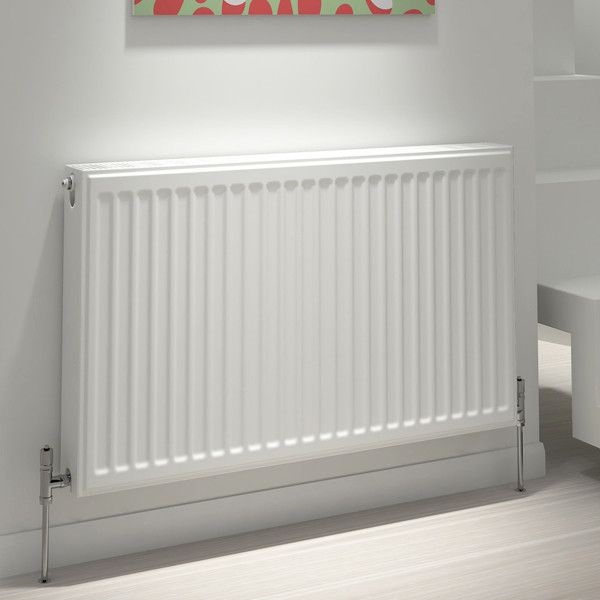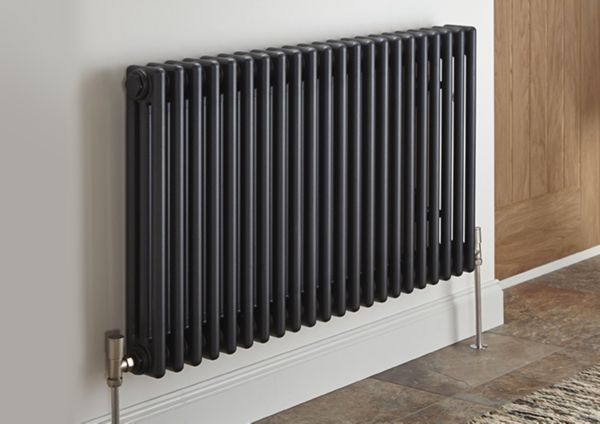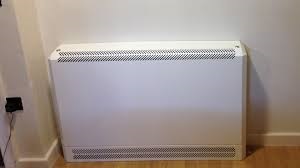Radiator
Contents |
[edit] Introduction
Radiators are heat exchanging devices and are one of the oldest and most effective ways of heating buildings. Typically, they consist of hollow metal panels through which hot water is pumped. Convector fins may be welded to the panels to increase their effective surface area, allowing more air to come into contact with the metal.
According to British Standards, radiators should be placed on external walls, wherever possible under windows. This is because mounting is easier on external walls and these are usually the coldest parts of a room.
Radiators use the heat from hot water or sometimes steam to warm the surrounding air. The advantage of using steam is that it can flow through pipes under its own pressure without needing pumps. This is useful for large and tall buildings, however, steam is less efficient due to the higher temperatures at which steam systems operate.
Water hammer is a banging sound that can be made by steam pipes and radiators. It is due to some of the steam condensing into water in a horizontal section of the steam piping and pushing the water at high velocity into a pipe fitting.
[edit] Types of radiator
[edit] Panel radiator
These can be either single or double panels without convector fins, and now largely outdated. The panel refers to the long metal containers that run parallel to the wall. The longer the panel, the larger the heat-emitting surface area, so bigger radiators will emit more heat. A double panel radiator will emit more heat than a single panel radiator of the same length.
[edit] Convector radiator
These are similar to panel radiators but have convector fins welded to them. The three different types are:
- Single panel single convector: One front steel panel and one convector fin.
- Double panel single convector: Two steel panels (front and back) and one convector fin.
- Double panel double convector: Two steel panels (front and back) and two convector fins.
Round top radiators allow the convector fins to be seen, whereas compact radiators include a grill across the top of the panels to obscure the view of the fins (see top image).
[edit] Column radiator
Column radiators are made up of steel tubular columns welded to end pieces at the top and bottom. Column radiators can range from single to four columns in depth. Column radiators are popular for their more traditional appearance.
[edit] LST radiator
An LST radiator has an efficient internal heat emitter in a robust steel enclosure to ensure safety and concealment of pipework and valves. This type of radiator is often found in places where safety concerns are important, such as hospitals, nurseries, schools, care homes, and so on. They do not have sharp corners and maintain a low, safe-to-touch surface temperature, while at the same time delivering the required heat output.
[edit] Skirting board radiator
This type of radiator is placed inside a skirting board, saving the wall space. Hot water is piped through the system from the central heating system.
[edit] Bleeding a radiator
Bleeding a radiator involves venting air that can build up over time, preventing proper operation of the radiator.
Radiators should be bled regularly to ensure the efficiency of the central heating system. It is possible to check whether bleeding is necessary by checking for cool spots, especially near the top of the radiator. Bleeding can be done using a bleeding key or flat-heated screwdriver to open a valve at one end of the radiator. This allows the release of the trapped air until liquid starts to escape, at which point the valve should be quickly closed.
Bleeding radiators may reduce the pressure of the central heating system to below its recommended level. Typically, a filling loop within the boiler can be used to re-pressurise the system.
NB New regulations mean that from June 2022, heating installers are required to install thermostatic room controls when replacing a boiler.
[edit] Related articles on Designing Buildings
- Boiler markets and the green recovery.
- Building heating systems.
- Building services.
- Fan convector.
- Heating.
- Hot water.
- HVAC.
- Mechanical, electrical and plumbing MEP.
- Natural convector.
- Pipework.
- Plumbing.
- Plumbing drawing.
- Thermal conduction in buildings.
- Types of heating system.
- Underfloor heating.
- Valves.
Featured articles and news
The UK's Modern Industrial Strategy: A 10 year plan
Previous consultation criticism, current key elements and general support with some persisting reservations.
Building Safety Regulator reforms
New roles, new staff and a new fast track service pave the way for a single construction regulator.
Architectural Technologist CPDs and Communications
CIAT CPD… and how you can do it!
Cooling centres and cool spaces
Managing extreme heat in cities by directing the public to places for heat stress relief and water sources.
Winter gardens: A brief history and warm variations
Extending the season with glass in different forms and terms.
Restoring Great Yarmouth's Winter Gardens
Transforming one of the least sustainable constructions imaginable.
Construction Skills Mission Board launch sector drive
Newly formed government and industry collaboration set strategy for recruiting an additional 100,000 construction workers a year.
New Architects Code comes into effect in September 2025
ARB Architects Code of Conduct and Practice available with ongoing consultation regarding guidance.
Welsh Skills Body (Medr) launches ambitious plan
The new skills body brings together funding and regulation of tertiary education and research for the devolved nation.
Paul Gandy FCIOB announced as next CIOB President
Former Tilbury Douglas CEO takes helm.
UK Infrastructure: A 10 Year Strategy. In brief with reactions
With the National Infrastructure and Service Transformation Authority (NISTA).
Ebenezer Howard: inventor of the garden city. Book review.
The Grenfell Tower fire, eight years on
A time to pause and reflect as Dubai tower block fire reported just before anniversary.
Airtightness Topic Guide BSRIA TG 27/2025
Explaining the basics of airtightness, what it is, why it's important, when it's required and how it's carried out.
Construction contract awards hit lowest point of 2025
Plummeting for second consecutive month, intensifying concerns for housing and infrastructure goals.
Understanding Mental Health in the Built Environment 2025
Examining the state of mental health in construction, shedding light on levels of stress, anxiety and depression.

























Comments